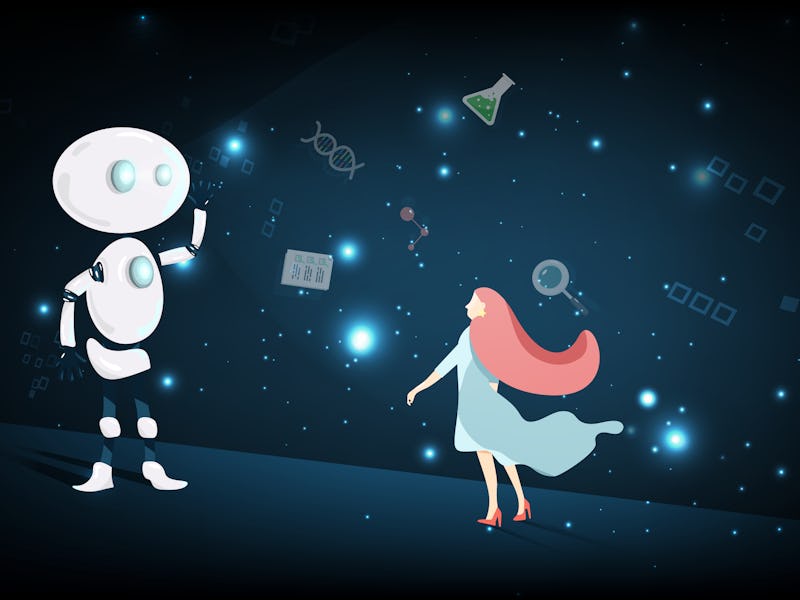Curious robot assistant helps scientists make novel discoveries
This robot is designed to explore for exploration's sake.

Being curious about the world is an important prerequisite to being a scientist and something that robots are traditionally not very good at. But a new study has shown how a curiosity-driven robot can help scientists make new, time-saving discoveries in the lab that they might not have made on their own. While this algorithmically driven, robotic scientist won't be replacing human scientists anytime soon, it can help speed up the discovery process for simple, yet poorly understood, physical systems.
The study, published Friday in the journal Science Advances, describes how scientists were able to make a novel discovery about how temperature affects oil droplet speed by using an algorithmically driven, automated oil-droplet robot. The physical task at hand was fairly simple: the robot was designed to automatically complete oil-droplet experiments in which different oil cocktails were dropped into Petri dishes, recorded by the robot and then repeated. But having the robot do so intelligently, was a little more complicated, write the authors.
In the paper, the authors describe the process of designing the curiosity algorithm in comparison to golf. Imagine you're a novice golfer with no previous experience of the game hitting the green for the first time. You know that you can choose between different clubs and that you can hit the ball with different intensities (the experimental parameters, write the authors) as well as where the hole at the end of the course is (the experimental observation space.) The question though, when it comes to designing curiosity, is what kind of random exploration of the question (or hitting green) should be done to discover something interesting.
This curiosity algorithm is designed to make a robot intelligently explore different experimental designs and out comes.
The authors write a robot could choose to vary parameters at random (in the golf scenario, choosing different hitting strengths at random) or it could instead choose a random objective (e.g. different distances for the ball to land at.) In the case of the curious science robot, the authors write that choosing random objectives has proven much more time effective than choosing only random parameters and that in their oil-drop experiment the random objectives chosen by the algorithm identified an anomaly that both the scientists and a random parameter algorithm missed.
In the oil-drop experiment the random-objective, curiosity algorithm was pitted against a random parameter algorithm and both were tasked with completing 1000 oil droplet trials autonomously, each lasting 90s. During the curiosity algorithm's first few trials, the team observed an unexpected change in the oil droplet's speed which they were able to determine were caused by a small change in ambient temperature. Choosing to vary those parameters specifically, the team observed that the curiosity algorithm generated significantly more varied droplet behaviors than a random parameter search alone, meaning that it was able to find more unique outcomes. The authors write that this leads them to believe that the unexpected change in the droplet's speed could have only been discovered by the curiosity algorithm. This discovery led the study's researchers to discover previously unknown characteristics about these simple oil droplets. In fact, the authors write that the curiosity algorithm was able to create more varied experimental outcomes in only 128 trials than the random parameter algorithm did in its full 1000 trials.
This discovery led the study's researchers to discover previously unknown characteristics about these simple oil droplets.
While this study focused specifically on how such a robot could be beneficial in explorations of chemistry, the authors write that it could be used to explore other similar, unfamiliar physical systems as well. This approach would save valuable time and resources for scientists and allow them to explore scientific questions unbias wide-eyed curiosity.
Abstract: We describe a chemical robotic assistant equipped with a curiosity algorithm (CA) that can efficiently explore the states a complex chemical system can exhibit. The CA-robot is designed to explore formulations in an open-ended way with no explicit optimization target. By applying the CA-robot to the study of self-propelling multicomponent oil-in-water protocell droplets, we are able to observe an order of magnitude more variety in droplet behaviors than possible with a random parameter search and given the same budget. We demonstrate that the CA-robot enabled the observation of a sudden and highly specific response of droplets to slight temperature changes. Six modes of self-propelled droplet motion were identified and classified using a time-temperature phase diagram and probed using a variety of techniques including NMR. This work illustrates how CAs can make better use of a limited experimental budget and significantly increase the rate of unpredictable observations, leading to new discoveries with potential applications in formulation chemistry.